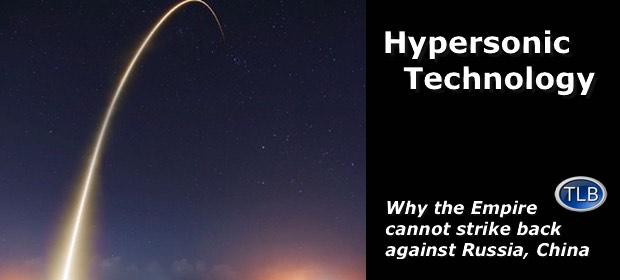
How Russia and China Gained a Strategic Advantage in Hypersonic Technology
FEDERICO PIERACCINI
A hot topic in military prognostications regarding China, Russia and the United States revolves around the development and use of hypersonic technology for missiles or UAVs as an invulnerable means of attack. As we will see, not all three countries are dealing successfully with this task.
The United States, China and Russia have in recent years increased their efforts to equip their armed forces with such highly destructive missiles and vehicles seen in the previous article. Putin’s recent speech in Moscow reflects this course of direction by presenting a series of weapons with hypersonic characteristics, as seen with the Avangard and the Dagger.
As confirmed by US Under Secretary of Defense for Research and Engineering, Dr. Michael Griffin:
We, today, do not have systems that can hold them [hypersonic weapons] at risk…and we do not have defenses against those [hypersonic] systems. Should they choose to deploy them we would be, today, at a disadvantage.
Further confirmation that the US is lagging in this field came from General John Hyten, Commander of US Strategic Command:
“We don’t have any defense that could deny the employment of such a weapon against us, so our response would be our deterrent force, which would be the triad and the nuclear capabilities that we have to respond to such a threat.”
The development of hypersonic weapons has been part of the military doctrine that China and Russia have been developing for quite some time, driven by various motivations. For one thing, it is a means of achieving strategic parity with the United States without having to match Washington’s unparallelled spending power. The amount of military hardware possessed by the United States cannot be matched by any other armed force, an obvious result of decades of military expenditure estimated to be in the range of five to 15 times that of its nearest competitors.
For these reasons, the US Navy is able to deploy ten carrier groups, hundreds of aircraft, and engage in thousands of weapon-development programs. Over a number of decades, the US war machine has seen its direct adversaries literally vanish, firstly following the Second World War, and then following the collapse of the Soviet Union. This led in the 1990s to shift in focus from one opposing peer competitors to one dealing with smaller and less sophisticated opponents (Yugoslavia, Syria, Iraq, Afghanistan, international terrorism). Accordingly, less funds were devoted to research in cutting-edge technology for new weapons systems in light of these changed circumstances.
This strategic decision obliged the US military-industrial complex to slow down advanced research and to concentrate more on large-scale sales of new versions of aircraft, tanks, submarines and ships. With exorbitant costs and projects lasting up to two decades, this led to systems that were already outdated by the time they rolled off the production lines. All these problems had little visibility until 2014, when the concept of great-power competition returned with a vengeance, and with it the need for the US to compare its level of firepower with that of its peer competitors.
Forced by circumstances to pursue a different path, China and Russia begun a rationalization of their armed forces from the end of the 1990s, focusing on those areas that would best allow them the ability to defend themselves against the United States’ overwhelming military power. It is no coincidence that Russia has strongly accelerated its missile-defense program by producing such modern systems as Pantsir and S-300/S-400, which allows for a defense against ballistic attacks and stealth aircraft. Countering stealth technology became an urgent imperative, and with the production of the S-400, this challenge has been overcome. With the future S-500, even ICBMs will no longer pose a problem for Russia. In a similar vein, China has strongly accelerated its ICBM program, reaching within a decade the ability to produce a credible deterrent with their equivalent of the Russian SS-18 Satan or the American LGM-30G Minuteman III, possessing a long range and multiple independent reentry vehicles (MIRVs) armed with nuclear warheads.
After sealing the skies and achieving a robust nuclear-strategic parity with the United States, Moscow and Beijing begun to focus their attention on the US anti-ballistic-missile (ABM) systems placed along their borders, which also consist of the AEGIS system operated by US naval ships. As Putin warned, this posed an existential threat that compromised Russia and China’s second-strike capability in response to any American nuclear first strike, thereby disrupting the strategic balance inherent in the doctrine of mutually assured destruction (MAD).
For this reason, Putin has since 2007 been warning Russia’s western partners that his country would develop a system to nullify the American ABM system. In the space of a few years, Russia and China have succeeded in this task, testing and entering into production various hypersonic missiles equipped with breakthrough technologies that will strongly benefit the entire scientific sector of these two countries, and against which the US currently has no counter.
Currently there are no defenses against hypersonic attacks; and given the trend of employing ramjet/scramjet engines on new generations of fighter jets, it seems that more and more countries will want to equip themselves with these game-changing systems. Russia, to counter America’s naval superiority, has already entered into service the Zircon anti-ship missile, and already plans an export version with a range of 300 kms.
India and Russia have long been working on the Brahmos, which is yet another type of hypersonic missile that could in the future be launched from the Su-57. Although it is a relatively new technology, hypersonic weapons are already causing more than a headache for many Western military planners, who are only coming to realize just how far they are lagging behind their competitors.
It will take a while for the US to close the hypersonic technological and scientific gap with China and Russia. Lockheed Martin has been awarded a contract to this end. In the meantime, the two Eurasian powerhouses are focusing on their overland integration via the Belt And Road Initiative (BRI) and the Eurasian Union, a strategic arrangement that denies the US and NATO the ability to easily intervene in an area so far inland, compounded by its inability to control the airspace, and ultimately outnumbered on the ground in any case.
The objective of the Russians and the Chinese is the realization of a highly defended (A2/AD) environment on their coasts and in their skies, which are buttressed by hypersonic weapons. In this way, Russia and China possess the means to disrupt the maritime logistical chain of the US Navy in the case of war. In addition, the A2/AD would be able to stop US power projection, thanks to HGV weapons able to sink aircraft carriers and target specific land-based ABM systems or logistic-chain hubs.
It is a defensive strategy that could potentially halt US Naval power projection as well as its ability to control the skies, two linchpins in the way the US plans to fight its wars. No wonder think-tanks in Washington and four-star generals are starting to sound the alarm on hypersonic weapons.
************
Original article
ER recommends other articles by Strategic Culture Foundation




